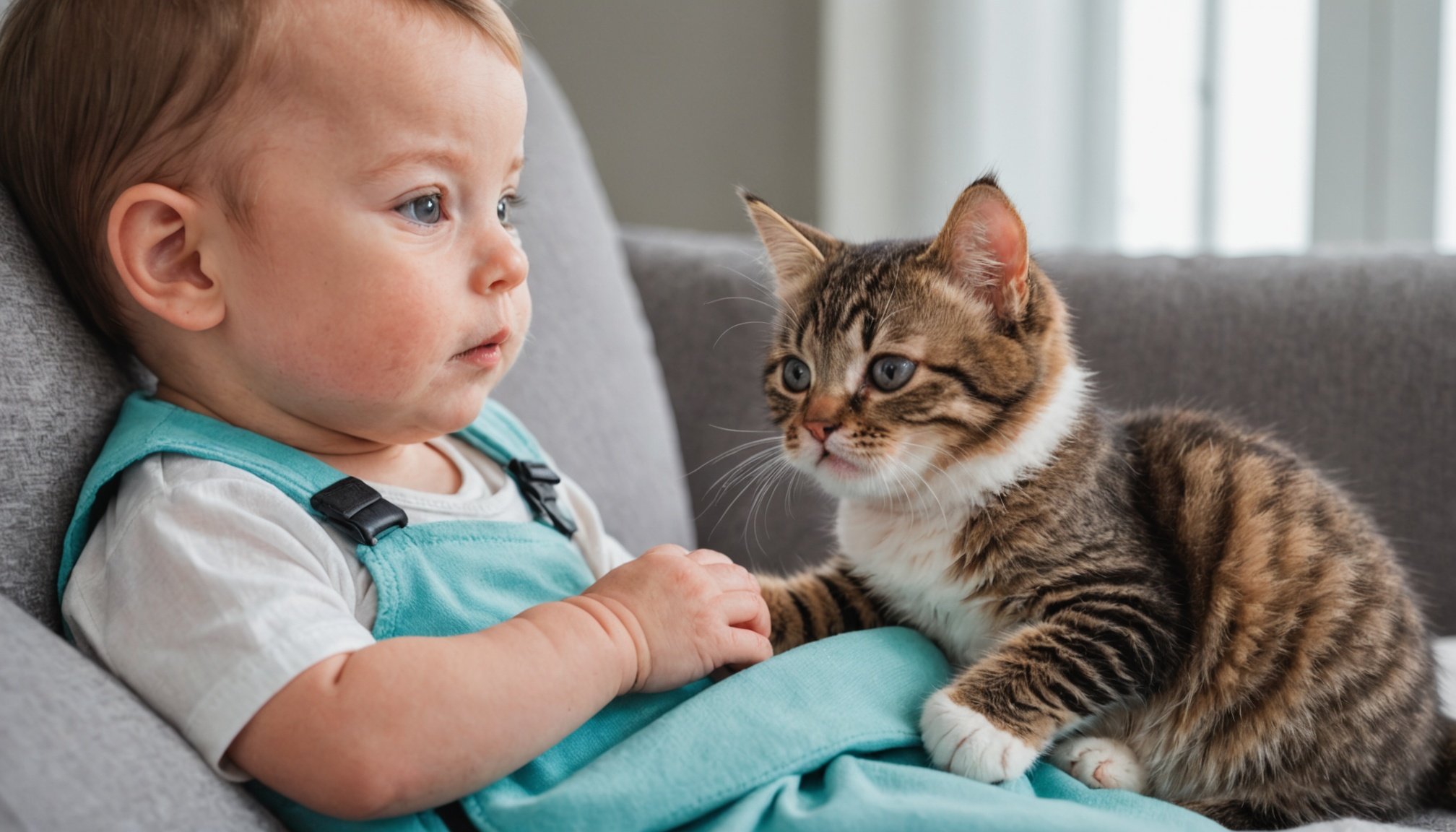Understanding Your Cat’s Behavior
A cat’s environment is essential in shaping its reactions and overall well-being. When faced with changes, such as the introduction of a new baby, cats often display unique behavioral adjustments. Understanding these responses is key to ensuring a harmonious household.
Cats typically express their feelings through various emotional responses. For instance, you might notice increased vocalization or a retreat into hiding. Such reactions often stem from stress or anxiety, as cats are creatures of routine and any disruption can unsettle them. Recognizing these signs early can aid in mitigating any negative behavior adjustments.
In parallel : Top techniques for reducing shedding in double-coated dog breeds: a comprehensive guide
Some common indicators of stress include:
- Excessive grooming
- Aggression or irritability
- Altered eating or litter box habits
To minimize stress, it helps to gradually introduce any environmental changes. Incorporate your understanding of feline instincts—like a cat’s need for territory and security—into your approach. Offer your cat a safe space to retreat and ensure that routines remain consistent.
Topic to read : Ultimate guide to thriving guppy fish breeding: top tips for success
When a new baby arrives, allow your cat to explore and sniff out the new addition at their own pace, ensuring reassurance through affection, thus easing their transition. Observing your cat’s behavior closely and addressing concerns promptly can foster a stable emotional environment for both your pet and your family.
Preparing Your Cat for the New Arrival
Introducing a baby to your home can be a significant change for your furry friend. Preparing your cat for baby requires careful planning to ensure a smooth transition. Begin with a gradual introduction to the changes that lie ahead.
Start by familiarizing your cat with baby gear such as cribs, strollers, and toys. Place these items in spaces where your cat often roams, allowing them to explore and sniff at their own pace. This step helps remove the mystery and potential fear associated with new objects.
Acclimate your cat to baby sounds by playing recordings of a baby’s crying or laughter. Begin with a low volume and slowly increase it over time. Recognising these sounds beforehand helps your cat stay calm when the real cries come.
Making pre-baby adjustments also includes maintaining a consistent routine. Cats thrive on stability, so feeding, play, and cuddle times should remain as regular as possible. A disruption in routine during such a pivotal time can increase stress levels for your kitty.
Lastly, provide a comforting environment by creating a safe space your cat can retreat to whenever they feel overwhelmed. This dedicated sanctuary supports their need for solitude amidst the changes. With preparation, your cat can smoothly adjust to the new family dynamics.
Creating a Safe Space for Your Cat
When a new baby arrives, creating a cat sanctuary becomes essential. This exclusive area helps ensure a stress-free environment for your cat, separate from the lively hustle and bustle your baby may bring. Here’s how to design and enhance such a space.
Begin by selecting a quiet corner or room within your home, away from the main activity areas. Having a designated zone allows your cat to retreat when they feel overwhelmed. For a truly inviting sanctuary, include necessities that contribute to their comfort and security. These may consist of:
- A cozy bed or soft blanket for sleeping
- Fresh water and reliable food supplies
- Toys to keep them entertained and mentally stimulated
- A sturdy scratching post to satisfy instinctual needs
Encouraging your feline friend to use their safe space requires patience and positive reinforcement. Gently guide them to their area with treats or toys, associating it with safety and enjoyment. Over time, this safe space for pets becomes a comforting haven where they can relax.
As a responsible pet owner, understanding your cat’s needs fosters a happier household. Creating a stress-free environment benefits everyone and helps your pet feel valued and understood.
## Introducing Your Baby to Your Cat
Navigating the **baby-cat introduction** process can be both exciting and nerve-wracking for pet owners. Ensuring that this delicate interaction is handled with care is crucial for fostering a harmonious environment.
Begin by orchestrating **supervised interactions** in a neutral space, where your cat feels at ease. Gradually introduce your pet to the new scents associated with your baby by allowing them to sniff clothing or blankets. This slow approach minimizes the chance of overwhelming your cat.
Positive reinforcement is paramount during these early stages. Reward your feline companion with treats or gentle praise when they exhibit calm behavior. This helps create a positive association with the presence of your baby, making them more comfortable and receptive to future encounters.
Closely monitor your cat's **body language** during introductions. Signs such as flattened ears, a swishing tail, or hissing may indicate stress or discomfort. If such behaviors occur, pause the interaction and provide your cat with a retreat to a safe space.
Remember to prioritize your cat's comfort by respecting their need for independence. Maintain a sense of routine, ensuring they have access to familiar areas in the home. These small steps contribute to successful, **safe introductions** and promote a peaceful coexistence with your new family member.
Maintaining Your Cat’s Routine
Keeping a steady cat routine management is vital for your pet’s well-being. A well-established routine significantly reduces stress for pets. Cats are creatures of habit, and any disruption can lead to anxiety.
To keep your cat’s feeding and playtime consistent, use a reliable schedule. Feed your cat at the same time each day, ensuring that the type and amount of food remain regular. This consistency reinforces their sense of security and predictability. Integrate playtime with their daily routine for mental and physical stimulation. This could be as simple as setting aside a few minutes in the morning and evening for interactive play.
Maintaining routine stability greatly influences your cat’s emotional well-being. When a cat knows what to expect from their day, they feel more secure, which can lead to fewer behavioral issues. A predictable environment fosters trust and comfort.
Involving older children in pet care can be beneficial as well. Assign them tasks such as feeding or playing, which enhances their responsibility while fostering a bond between the child and the pet. Encouraging children to participate not only helps in managing the routine but also teaches them empathy and kindness towards animals, contributing to a harmonious household.
Supporting Your Cat’s Emotional Needs
Understanding how to support your cat’s emotional health is crucial during times of change. Recognizing signs of feline anxiety is the first step. Cats are creatures of habit, and sudden alterations to their environment or routine, such as the arrival of a new baby, can trigger anxiety. Look for changes in behavior like excessive grooming, hiding, or aggressive tendencies.
Creating a supportive environment can ease your cat’s stress. This includes establishing safe zones where they can retreat for solace, ensuring these are calm areas free from disturbances. Installing pheromone diffusers can also aid in reducing anxiety, providing a sense of familiarity and comfort to your pet.
Spending quality time with your cat reinforces their sense of security. Daily play sessions cater to their physical and emotional needs, helping them burn excess energy while cementing your bond. Remember, even with a busy schedule, dedicating some uninterrupted moments for affection can significantly reassure them.
To bolster feline anxiety management, introduce changes gradually. If a baby’s arrival is on the horizon, acclimate your cat to new baby-related items and sounds slowly. This proactive approach ensures your cat adapts to the new dynamics, maintaining a harmonious home environment for everyone.
Safety Measures for Cats and Babies
Creating a safe environment for both cats and babies requires strategic planning to ensure peace and safety. Homes must be adaptable to cater to both, without compromising the well-being of either.
One primary step is pet-proofing. This includes securing loose wires and small objects that might intrigue curious kittens or crawling infants. Lock mechanisms on cabinets ensure little fingers—and paws—remain unharmed.
For harmonious coexistence, designate a special area for your cat. This space acts as a haven when your pet seeks a quiet moment amidst the bustling home. Such a space should be away from baby’s toys and sleeping area to prevent accidental scratches or bites.
When assessing common household items, consider those with sharp edges or tiny components, such as toys and decor. These could pose risks of injury or choking to both your baby and cat. Keeping such items out of reach or replacing them with safer alternatives reduces these threats.
Regularly inspecting your home from both a child’s and a cat’s perspective will unearth potential hazards. By integrating these safety measures, you ensure a welcoming and secure environment, fostering a positive relationship between your baby and cat.
Expert Tips from Veterinarians and Trainers
Introducing a newborn into a household where a cat already resides can pose unique challenges, especially concerning the cat’s emotional health. Veterinarian tips often highlight the importance of maintaining your cat’s routine to prevent anxiety. Consistency in feeding times and ensuring a quiet, undisturbed space can greatly ease this transition. Experts advise paying attention to your cat’s body language, as subtle changes may indicate stress.
Professional cat training can be an invaluable resource when facilitating interaction between your cat and the newborn. Trainers suggest using positive reinforcement to teach your cat how to behave around the baby. Techniques such as reward-based training can encourage positive associations with the new family member.
If additional guidance is needed, expert advice for cat integration can be sought from dedicated resources such as pet behavioral specialists or online forums. Frequently, these platforms offer tailored advice, putting pet owners in touch with seasoned trainers or veterinarians. It can be beneficial to invest in such expert advice to ensure a harmonious home environment.
Staying proactive and informed about integrating a newborn will not only support your cat’s emotional health but also promote a safer, happier living situation for everyone involved.











